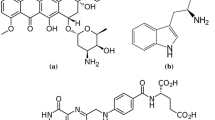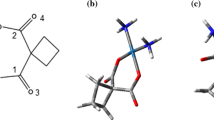Abstract
Carbon nanotubes (CNTs) are widely used in drug delivery systems (DDSs) due to their unique chemical and physical properties. Investigation of interactions between biomolecules and CNTs is an interesting and important subject in biological applications. In this study, we used molecular dynamics (MD) simulation to investigate the adsorption mechanism of the anticancer drug paclitaxel (PTX) on pristine and functionalized CNTs (f-CNT) in aqueous solutions. Our theoretical results show that PTX can be adsorbed on sidewalls of CNT in different methods. In the case of f-CNTs, PTX can be adsorbed on the functional groups due to the existence of polar interactions. These interactions in the CNT functionalized with polyethylene glycol (PEG), are more than the other investigated systems. Furthermore, it was found that the solubility of CNTs in aqueous solution is increased by functionalization. This is related to the intermolecular hydrogen bonds between functional groups and solvent molecules. The PEG group has the greatest effect on the solubility of the CNT in aqueous solution due to more polar interactions.









Similar content being viewed by others
References
Cragg GM, Grothaus PG, Newman DJ (2009) Impact of natural products on developing new anti-cancer agents. Chem Rev 109:3012–3043
Kushwaha S, Rastogi A, Rai A, Singh S (2012) Novel drug delivery system for anticancer drug: a review. SphinxsaiCom 4:542–553
Vashist SK, Zheng D, Pastorin G, et al. (2011) Delivery of drugs and biomolecules using carbon nanotubes. Carbon 49:4077–4097
Rowinsky EK, Donehower RC (1995) Paclitaxel (taxol). N Engl J Med 332:1004–1014
Ma P, Mumper RJ (2013) Paclitaxel nano-delivery systems: a comprehensive review. J Nanomed Nanotechnol 4:1000164
Sun H, She P, Lu G, et al. (2014) Recent advances in the development of functionalized carbon nanotubes: a versatile vector for drug delivery. J Mater Sci 49:6845–6854. doi:10.1007/s10853-014-8436-4
Jain KK (2012) Advances in use of functionalized carbon nanotubes for drug design and discovery. Expert Opin Drug Discov:1–9. doi:10.1517/17460441.2012.722078
Lay CL, Liu HQ, Tan HR, Liu Y (2010) Delivery of paclitaxel by physically loading onto poly (ethylene glycol)(PEG)-graftcarbon nanotubes for potent cancer therapeutics. Nanotechnology 21:65101
Arsawang U, Saengsawang O, Rungrotmongkol T, et al. (2011) How do carbon nanotubes serve as carriers for gemcitabine transport in a drug delivery system? J Mol Graph Model 29:591–596
Li Z, Tozer T, Alisaraie L (2016) Molecular dynamics studies for optimization of noncovalent loading of vinblastine on single-walled carbon nanotube. J Phys Chem C 120:4061–4070
Mousavi SZ, Amjad-Iranagh S, Nademi Y, Modarress H (2013) Carbon nanotube-encapsulated drug penetration through the cell membrane: an investigation based on steered molecular dynamics simulation. J Membr Biol 246:697–704
Liu Z, Chen K, Davis C, et al. (2008) Drug delivery with carbon nanotubes for in vivo cancer treatment. Cancer Res 68:6652–6660
http://www.jcrystal.com/products/wincnt/, Nanotube Modeler, JCrystalSoft Ed., 2004–2005
Maata J, Vierros S, Van Tassel PR, Sammalkorpi M (2014) Size-selective, noncovalent dispersion of carbon nanotubes by PEGylated lipids: a coarse-grained molecular dynamics study. J Chem Eng Data 59:3080–3089
Schmidt MW, Baldridge KK, Boatz JA, et al. (1993) General atomic and molecular electronic structure system. J Comput Chem 14:1347–1363
Ghadamgahi M, Ajloo D (2015) Molecular dynamics insight into the urea effect on Tretinoin encapsulation into carbon nanotube. J Braz Chem Soc 26:185–195
Brooks BR, Brooks CL, MacKerell AD, et al. (2009) CHARMM: the biomolecular simulation program. J Comput Chem 30:1545–1614
He Z, Zhou J (2014) Probing carbon nanotube--amino acid interactions in aqueous solution with molecular dynamics simulations. Carbon 78:500–509
Zaboli M, Raissi H (2016) The influence of nicotine on pioglitazone encapsulation into carbon nanotube: the investigation of molecular dynamic and density functional theory. J Biomol Struct Dyn 1102:1–15. doi:10.1080/07391102.2016.1152565
Zoete V, Cuendet MA, Grosdidier A, Michielin O (2011) SwissParam: a fast force field generation tool for small organic molecules. J Comput Chem 32:2359–2368
Jorgensen WL, Chandrasekhar J, Madura JD, et al. (1983) Comparison of simple potential functions for simulating liquid water. J Chem Phys 79:926–935
Kirkwood JG (1935) Statistical mechanics of fluid mixtures. J Chem Phys 3:300–313
Hess B, Kutzner C, Van Der Spoel D, Lindahl E (2008) GROMACS 4: algorithms for highly efficient, load-balanced, and scalable molecular simulation. J Chem Theory Comput 4:435–447
Berendsen HJC, JPM P, van Gunsteren WF, et al. (1984) Molecular dynamics with coupling to an external bath. J Chem Phys 81:3684–3690
Humphrey W, Dalke A, Schulten K (1996) VMD: visual molecular dynamics. J Mol Graph 14:33–38
Izadyar A, Farhadian N, Chenarani N (2016) Molecular dynamics simulation of doxorubicin adsorption on a bundle of functionalized CNT. J Biomol Struct Dyn 34:1797–1805
Toosy NKA, Raissi H, Zaboli M (2016) Theoretical calculations of intramolecular hydrogen bond of the 2-amino-2, 4, 6-cycloheptatrien-1-one in the gas phase and solution: substituent effects and their positions. J Theor Comput Chem 15:1650063
Khoshbin Z, Raissi H, Zaboli M (2015) The DFT and MP2 based computational scrutiny on blue-shifted H--F stretching vibrational frequencies in hydrogen-fluoride complexes with nitriles: Insights into the decisive role of intermolecular hydrogen bonding (IMHB) in ground and electronic excited states. Arab J Chem doi:10.1016/j.arabjc.2015.06.003
Small PA (1953) Some factors affecting the solubility of polymers. J Appl Chem 3:71–80
Faujan NH, Karjiban RA, Kashaban I, et al. (2015) Computational simulation of palm kernel oil-based esters nano-emulsions aggregation as a potential parenteral drug delivery system. Arab J Chem doi:10.1016/j.arabjc.2015.03.003
Lee B, Richards FM (1971) The interpretation of protein structures: estimation of static accessibility. J Mol Biol 55:379–400
Ausaf Ali S, Hassan I, Islam A, Ahmad FA (2014) Review of methods available to estimate solvent-accessible surface areas of soluble proteins in the folded and unfolded states. Curr Protein Pept Sci 15:456–476
Author information
Authors and Affiliations
Corresponding author
Electronic supplementary material
ESM 1
(DOCX 731 kb)
Rights and permissions
About this article
Cite this article
Hashemzadeh, H., Raissi, H. The functionalization of carbon nanotubes to enhance the efficacy of the anticancer drug paclitaxel: a molecular dynamics simulation study. J Mol Model 23, 222 (2017). https://doi.org/10.1007/s00894-017-3391-z
Received:
Accepted:
Published:
DOI: https://doi.org/10.1007/s00894-017-3391-z




